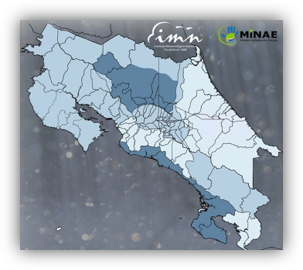Weather warnings
Jun
29
Aviso Meteorológico Informativo
Tormenta Tropical Beryl avanza sobre el Océano Atlántico
29 de junio de 2024
2.25 pm
Diagnóstico: La mañana de este sábado la Depresión Tropical 2 evolucionó en la Tormenta Tropical Beryl. De acuerdo al último informe del NHC de las 18 UTC (12 md hora local), este ciclón se...
Jun
29
Weather Warning
Central American Gyre influence decreases this Saturday
June 29, 2024
10:30 a.m.
Diagnosis: The Central American Gyre (CAG) maintains showers with storms on the coast and surrounding areas in Guanacaste this Saturday morning. The accumulated amounts in the last 6 hours vary...
Jun
28
Informative Meteorological Notice
Tropical Depression 2 formed in the Atlantic Ocean
June 28, 2024
5:35 p.m.
Diagnosis: On Friday afternoon, tropical wave n°16 evolved into Tropical Depression 2 (DT 2). According to the NHC, this cyclone will be strengthening into a tropical storm in the next few hours...
Jun
28
Weather Warning (Update)
Influence of the Central American Gyre continues this Friday (update)
June 28, 2024
4:15 p.m.
Diagnosis: This Friday, a predominance of humidity flow from the Pacific Ocean to the national territory continues, due to the development of the Central American Gyre in the region. During the...
Jun
28
Weather Warning
Central American Gyre continue the influence this Friday
June 28, 2024
10:00 a.m.
Diagnosis: This Friday a predominance of humidity flow from the Pacific Ocean to the national territory continues, this due to the development of a Central American Gyre in the region....
Weather warnings history
In this section you will find the weather warnings history.
Weather Warning-IMN-270624-8:00 a.m.
Jun
27
Weather Warning
Instability of tropical wave #13 and the Central American Gyre for this Thursday
June 27, 2024
8:00 a.m.
Diagnosis: Tropical wave #13 over the waters of the North Pacific of our country leaves instability in its wake, which is added to the presence of southwesterly flows throughout the Pacific slope, typical of the Central American Gyre. At this time, there are showers in coastal and surrounding areas of the Pacific slope and occasional rains in the Central Valley. The amounts recorded in the last 12 hours are between 10 - 50 mm with local maximums of up to 100 mm (west of the Nicoya Peninsula).
Forecast: For the rest of the morning, during the afternoon and early evening, the entry of humidity and cloudiness will continue on the Pacific slope, with the presence of localized rains and showers, which will be perceived with greater intensity on the coasts of the Central Pacific, around the Golfo Dulce and also in most of the North Pacific. The estimated amounts in 12-hour periods would be between 20 - 50 mm with punctual maximums of 70 - 100 mm.
For the Central Valley, cloudy conditions are forecast with moderate to weak and intermittent rains. The estimated amounts would be between 10 - 50 mm.
The low regions of the center of the Northern Zone together with sectors close to the mountains of the Caribbean, will maintain a medium probability of development of isolated showers with storms for the afternoon period. The estimated amounts, although isolated, would be between 30 - 50 mm with punctual maximums of 70 mm.
The IMN is closely monitoring the evolution of these disturbances in the atmosphere and will be updating the information if necessary.
Warning: Saturated soils are monitored in the South Pacific and North Pacific (special attention to both peninsulas), mountains of the Northern Zone bordering the Central Valley and those of the Guanacaste mountain range. All regions are vulnerable to landslides and possible floods.
Because of the above, the IMN recommends:
• Caution due to sewer saturation in places prone to this type of flooding.
• Prevention against electrical storms and seek shelter in a safe place in case of strong gusts of wind near storm clouds, due to the possible fall of tree branches, power lines, among others. These gusts can reach 80 km/h in some isolated cases.
• Stay informed through social networks, Twitter: @IMNCR, Facebook: Instituto Meteorológico Nacional CR and the WEB Page: www.imn.ac.cr
Jose Pablo Valverde Mora
Meteorologist
DMSA-IMN
 RSS IMN latest alerts(Local Notification): https://www.imn.ac.cr/en/web/imn/avisos-meteorologicos/-/asset_publisher/lTlyP4wEZlDa/rss
RSS IMN latest alerts(Local Notification): https://www.imn.ac.cr/en/web/imn/avisos-meteorologicos/-/asset_publisher/lTlyP4wEZlDa/rss 


